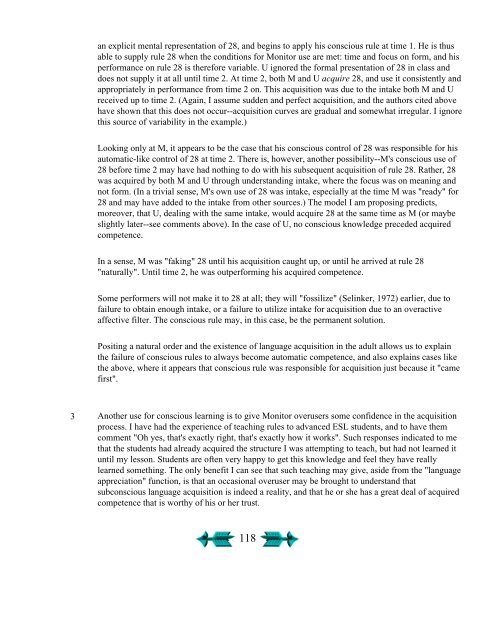Second Language Acquisition and Second ... - Stephen Krashen
Second Language Acquisition and Second ... - Stephen Krashen
Second Language Acquisition and Second ... - Stephen Krashen
You also want an ePaper? Increase the reach of your titles
YUMPU automatically turns print PDFs into web optimized ePapers that Google loves.
an explicit mental representation of 28, <strong>and</strong> begins to apply his conscious rule at time 1. He is thus<br />
able to supply rule 28 when the conditions for Monitor use are met: time <strong>and</strong> focus on form, <strong>and</strong> his<br />
performance on rule 28 is therefore variable. U ignored the formal presentation of 28 in class <strong>and</strong><br />
does not supply it at all until time 2. At time 2, both M <strong>and</strong> U acquire 28, <strong>and</strong> use it consistently <strong>and</strong><br />
appropriately in performance from time 2 on. This acquisition was due to the intake both M <strong>and</strong> U<br />
received up to time 2. (Again, I assume sudden <strong>and</strong> perfect acquisition, <strong>and</strong> the authors cited above<br />
have shown that this does not occur--acquisition curves are gradual <strong>and</strong> somewhat irregular. I ignore<br />
this source of variability in the example.)<br />
Looking only at M, it appears to be the case that his conscious control of 28 was responsible for his<br />
automatic-like control of 28 at time 2. There is, however, another possibility--M's conscious use of<br />
28 before time 2 may have had nothing to do with his subsequent acquisition of rule 28. Rather, 28<br />
was acquired by both M <strong>and</strong> U through underst<strong>and</strong>ing intake, where the focus was on meaning <strong>and</strong><br />
not form. (In a trivial sense, M's own use of 28 was intake, especially at the time M was "ready" for<br />
28 <strong>and</strong> may have added to the intake from other sources.) The model I am proposing predicts,<br />
moreover, that U, dealing with the same intake, would acquire 28 at the same time as M (or maybe<br />
slightly later--see comments above). In the case of U, no conscious knowledge preceded acquired<br />
competence.<br />
In a sense, M was "faking" 28 until his acquisition caught up, or until he arrived at rule 28<br />
"naturally". Until time 2, he was outperforming his acquired competence.<br />
Some performers will not make it to 28 at all; they will "fossilize" (Selinker, 1972) earlier, due to<br />
failure to obtain enough intake, or a failure to utilize intake for acquisition due to an overactive<br />
affective filter. The conscious rule may, in this case, be the permanent solution.<br />
Positing a natural order <strong>and</strong> the existence of language acquisition in the adult allows us to explain<br />
the failure of conscious rules to always become automatic competence, <strong>and</strong> also explains cases like<br />
the above, where it appears that conscious rule was responsible for acquisition just because it "came<br />
first".<br />
3 Another use for conscious learning is to give Monitor overusers some confidence in the acquisition<br />
process. I have had the experience of teaching rules to advanced ESL students, <strong>and</strong> to have them<br />
comment "Oh yes, that's exactly right, that's exactly how it works". Such responses indicated to me<br />
that the students had already acquired the structure I was attempting to teach, but had not learned it<br />
until my lesson. Students are often very happy to get this knowledge <strong>and</strong> feel they have really<br />
learned something. The only benefit I can see that such teaching may give, aside from the "language<br />
appreciation" function, is that an occasional overuser may be brought to underst<strong>and</strong> that<br />
subconscious language acquisition is indeed a reality, <strong>and</strong> that he or she has a great deal of acquired<br />
competence that is worthy of his or her trust.<br />
118











